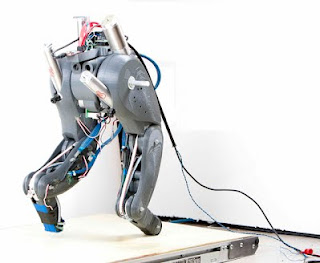BBC News - 'Most realistic' robot legs developed
US experts have developed what they say are the most biologically-accurate robotic legs yet.Writing in the Journal of Neural Engineering, they said the work could help understanding of how babies learn to walk - and spinal-injury treatment.
They created a version of the message system that generates the rhythmic muscle signals that control walking.
A UK expert said the work was exciting because the robot mimics control and not just movement.
RNSL University of Arizona
RNSL: Robotics and Neural Systems Laboratory
We are interested in understanding biological movement, vision and intelligence.
We use non-traditional methods. We build simulations or models of systems in software and test them in hardware to try to understand their biological counterparts. This requires the integration of a large amount of information across the biological sciences and then the implementation of electrical and mechanical engineering techniques.
A secondary goal is to advance robotic theory. We often try to translate understanding derived from biology into new robotic methods that offer solutions to real world problems.
Source: RNSL University of Arizona
U of Arizona Researchers Build Bipedal Robot
Dr. M. Anthony Lewis, Director of the Robotics and Neural Systems Lab at the University of Arizona, and Theresa J. Klein (PhD student) have been working on a biarticulate muscle leg model. In a paper published in 2008 (available at the lab’s website), they describe how motors pulled on stiff, tendon-like Kevlar straps to reproduce the action of key muscle groups.
Their new biped robot features an improved leg design that models even more muscles. And it’s already walking (though it relies on a babywalker-like support for balance). It stands 55 cm (22″) tall with the legs fully extended and weighs approximately 4.5 kg (10 lbs).
Leggy Robot (Almost) Moves Like Jagger | Observations, Scientific American Blog Network
Like many roboticists, Lewis and Klein looked to nature for inspiration. Humans have a central pattern generator (CPG) in their spinal cord’s lumbar region. The CPG is a neural network producing rhythmic signals that allow the body to generate the step cycle needed for locomotion. The CPG creates and controls these signals based on information it gathers from the legs, which indicate, for example, the slope and solidity of a surface as they walk.
Lewis and Klein’s robot features the simplest form of a CPG—just two neurons that fire signals alternately to produce a rhythm, as well as load sensors that determine force in the limb when each leg presses against a stepping surface. This setup is similar to the mental mechanism that allows human babies to learn to walk—a pair of neurons enables their little legs to work in rhythm with practice.
Each leg of the university’s robot consists of a hip, knee and ankle moved by nine muscle actuators. Muscle contraction is mimicked by rotating the motor to pull on Kevlar straps. Each muscle strap features a load sensor that models a tendon in a human leg, sensing muscle tension when a muscle is contracted and sending signals to the brain about how much force is being exerted and where.
Related
- Robotic legs mimic how babies walk | Fox News
- New robotic legs may lead to more human-like robots | The Bunsen Burner
- Robot legs accurately mimic human movement | The Verge
- 33rd Square | Bipedal Robot Uses Neural Net To Walk Like A Baby
- 'Realistic' robot legs - Health News - NHS Choices
- First robotic legs to fully model biologically accurate walking | KurzweilAI
- A physical model of sensorimotor interactions during locomotion - IOPscience


